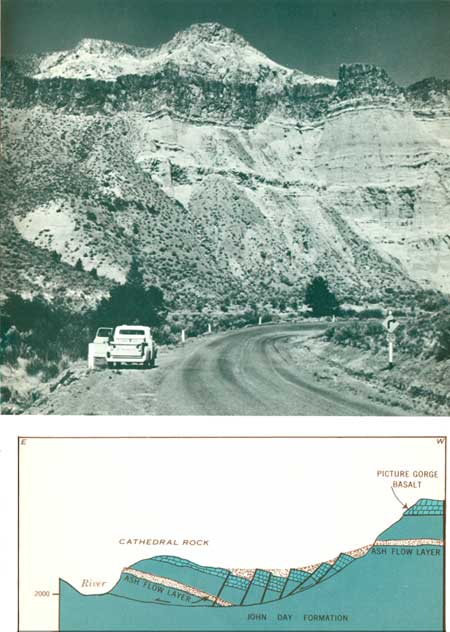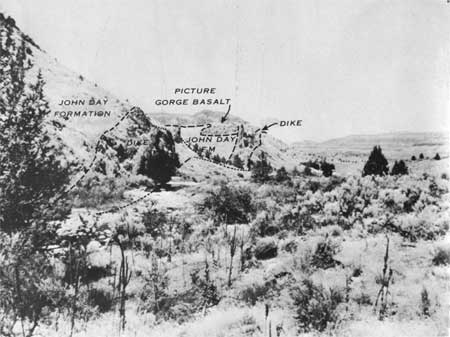
|
Geological Survey
The Geologic Setting of the John Day Country, Grant County, Oregon
|
ROAD LOG OF THE JOHN DAY "LOOP"
(continued)
| E. 126.0 |
Picture Gorge. Visible to the left of
Picture Gorge, from north around to west, in order of their
deposition and geologic age from oldest to youngest, are the Picture Gorge Basalt,
Mascall Formation, and Rattlesnake Formation (Fig. 5). The Picture
Gorge Basalt flows and ashy beds of the Mascall Formation were tilted
southward together and eroded before the Rattlesnake Formation was laid
down horizontally across them. Picture Gorge and the present valley were
then cut by the John Day River after the Rattlesnake Formation had been
tilted in its turn. The five benches or terraces on the basalt just east
of Picture Gorge mark temporary halts in downcutting of the John Day
River.
|

|
|
Fig. 5.—North-south section along the John Day
River through Picture Gorge and Middle Mountain. (click on image for
an enlargement in a new window)
|
|
| F. 122.0 |
Thomas Condon Viewpoint, John Day Fossil Beds
State Park (now National Monument). From Picture Gorge to the cliffs opposite, the
Picture Gorge Basalts and varicolored ash beds of the John Day Formation
rise together nearly 2000 feet. The basalt that caps Sheep Rock is an
erosional remnant. The lower beds in the John Day Formation are colored
red by clay eroded from thick soil on the Clarno Formation, which is
exposed in the farthest red hill. The soil was formed by tropical
weathering some 30-35 million years ago, before the John Day Formation
was laid down. Faulting on a small scale is illustrated in Sheep Rock,
where the thick olive-drab ash flow in the middle of the John Day
Formation is offset 75-100 feet (Fig. 6). The fault slopes about 45°
eastward. About two miles down stream, large-scale movement on two
faults has dropped the basalt flows in Middle Mountain 2000-2500 feet.
One of the faults follows along the upstream base of Middle Mountain
(Fig. 6).
|

|
|
Fig. 6.—Sheep Rock from Thomas Condon (now Sheep Rock) viewpoint.
|
|
| G. 118.7 |
Munro (now Blue Basin) Area, John Day Fossil Beds State Park (now
National Monument).
The valley of the John Day River has been widened to nearly five miles
by erosion in the John Day Formation. Large tilted slide blocks of the
John Day Formation and basalts jumbled together show how important
landsliding of soft beds under hard rocks can be in widening
valleys.
Here one can appreciate the regularity and extent of basalt
flows of the flood or plateau type, which form the Columbia
Plateau. Individual flows have been traced 100 miles. Travelers
will see few other rocks between here and The Dalles, Wenatchee,
Pendleton, or Spokane as they cross parts of the Columbia Plateau.
|
| H. 116.2 |
Cathedral Rock. The bluff called Cathedral Rock is the
front face of a large block of the John Day
Formation that has slid from the west (Fig. 7). Inside the next
horseshoe bend downstream a large mass of basalt is tilted down against
Cathedral Rock. From the highway 1.1 miles farther north one can see the
side of the tilted block along the river, and the same two prominent red
and olive-drab ash layers in the high bluff from which the block slid.
The horseshoe bend was formed as the river was pushed eastward by the
nose of the landslide.
|

|
|
Fig. 7.—View of Cathedral Rock and diagram of landsliding.
|
|
| J. 107.0 |
Kimberly Dike. The low
bluff across the river is formed by a vertical dike of basalt
which is about 60 feet wide. This dike cuts
through the John Day Formation and, farther north,
the Picture Gorge Basalt (Fig. 8). It crosses the river valley
diagonally and can be traced nearly four miles. The dike is formed of
once-molten rock that "froze" in a fissure which was a channelway for
lava that fed a flow on the earth's surface. Many similar dikes are
visible along the road east of Kimberly. The basaltic magma is believed
to have originated at depths of 40 miles or more within the part of the
earth called the mantle.
(At 105.3 turn east on State Highway 402 along the
North Fork of the John Day River)
|

|
|
Fig. 8.—Basalt dike two miles south of Kimberly.
|
|
inf/john_day/sec3a.htm
Last Updated: 28-Mar-2006
|
